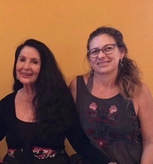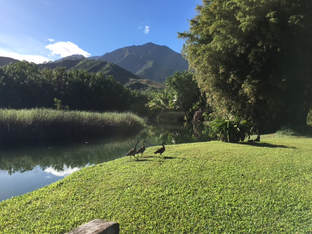 It was a full moon night as our plane touched ground in the garden island of Kauai, Hawaii. The fragrance of exotic flowers wafted through the indoor/outdoor airport. As Hawaiian music played in the background, Mira, my daughter and I just looked at each other. Her look was of joy to luxuriate in the warmth of the air and sounds of the sea. Mine was of longing for the cold and snowy climate of Christmas. In the morning we awoke as the sun rose over the distant mountains. A river lazily passed by the screened lanai where we were sleeping. Exotic birds were singing as a family of geese pranced by with their small offspring sandwiched between them. Bandied roosters sped by our window as a whitish looking owl flew over the calm river where the fish would jump at dusk. My heart filled with love and gratefulness to be brought to this place after a year of continual travel and teaching. What a blessing it is, wherever I go, to share yoga and the Yoga Sutras! The green all around was exhilarating and brought vibrancy back to my tired body. After a summer of heat waves my attachment to snow and cold dropped away as I slipped gently into this paradisiacal moment in time. Even though Hawaii was testing it’s siren that would warn of a missile attack from North Korea, the people did not seem frightened, and life on this island drifted on as usual. Right here and now, this felt like a fiefdom of serenity and sanctity in the midst of political storms swirling around the planet. Mira and I decided to take a media fast and live in the beauty and peace of each moment. The world cannot reach us here, I thought as concerns of the future dissolved into an ocean of “all-thing-ness.” The ever-changing clouds passed over the peaks of majestic mountains, one range taller than the next. They seemed to stand like sentries of protection for those who live in their shadows. As I gazed at the mountain, I was reminded of a passage from the Mahabharata, the great epic of India, “As a man on the hilltop sees a man on the plains, so one having ascended the palace of knowledge and becoming free from sorrow now sees others who are suffering.” As I reveled in the embrace of this magical island, the concept of suffering seemed a world away. As the lyrical songs of birds swirled through the air, I realized that in the perfection of this moment, there is no conflict between nations, states and people. There is no suffering of the pathos from the aftermath of war or fear of impending wars. In this moment there is no regret of the past or anxiety of the future, there is no justice or injustice, rights and wrongs. There is only the eternal “Now!” All of yoga seems to be about cultivating that “Now” through practices that create calmness of the waves of the mind. In that state I wondered, is there any pain or suffering in self, community or the world? Is there a place of peace that already shines like the sun above the clouds and is always shedding its light even though we may not always see or feel it. I walked a few feet to the edge of the river. Its placid surface was like a mirror reflecting my own image. As I gazed into the water, I thought of the Sutra 1.3, “Tada Drastuh Swarupe Avasthanam.” When the waves of the mind become calm then, “The seer and seen become one,” or is it “realize the Oneness that already is?” Suddenly, a fish jumped creating a circular ripple that expanded to the banks of the river. Even though I could no longer see my own reflection, I thought how these ripples were like the unending rings of compassion. How can we feel what another feels until we have ascended the hilltops and dried our own tears so that we can see and feel the tears of others? Until then, as the ancient yogis say, what we think is unattachment, is only indifference. There is a wonderful commentary in the Yoga Sutras, “To the yogin, who is as sensitive as an eyeball, the world is painful.” Yoga awakens our sensitivity like a cobweb drawn across the ball of the eye. If the same cobweb is drawn over the thickest skin of our arm would we feel it? The sensitivity of an eyeball is an example of our conscience. Things we may have not felt at one time, now through our practices, we can feel and understand its affects upon ourselves and others. When we realize how we have knowingly or unknowingly wounded the hearts of others and actually feel their pain, we cultivate compassion. When we soften the hardened areas of our heart to forgive those who may have knowingly or unknowingly wounded our heart, we cultivate forgiveness and in turn, compassion. There is a practice in Hawaiian culture, which works with forgiveness and reconciliation, called Ho’oponopono. Although many people are familiar with its modern day application, many do not know its history and use within the ancient Hawaiian culture. The Hawaiians, much like the yogis, believe that illness is a result of breaking ‘spiritual laws’ called Kapu in Hawaiian, transgressions that may have harmed another (like the law of Karma in Yoga). They believe illness is caused by the stress of anger, guilt and holding on to the memories of the past. In order to heal the illness, the deeper issues of the mind must be healed and forgiveness sought from the person/s involved. Or if that is not possible… from the Gods. This was done using a Kahuna, a healing priest who would perform Ho’oponopono ceremony by gathering the family or persons involved. The priest would open the gathering with prayer allowing the stories to be told and emotions released. Once the roots of the hurt had been acknowledged, then they would release the held emotions and end with a reconciliation feast. Perhaps this is the origin of why families get together for holiday feasts. In modern times, Ho’oponopono was combined with practices from India and China and the concept of Karma. It took the form now known as a mantra repeated over and over, “I love you. I’m sorry. Please forgive me. Thank you.” This involves healing the origins of conflict by taking full responsibility for our own actions knowing that everything that exists outside is a projection of the inner landscape. This is aligned with the practices of yoga and the sutra that speaks of the yogin as being as “sensitive as an eyeball.” This means that whatever hurt ripples from our own consciousness is immediately felt and rectified in the moment. The Christmas hustle and bustle may not be outwardly evident in this corner of the world, but the spirit of Christmas is ever present within this ancient wisdom tradition. Here, the Hawaiian Christmas tree stands solidly in the ground, free from ornaments, shining in its own symmetrical glory. The spirit of Aloha supports the spirit of the Holidays, which in the Hawaiian culture is timeless and eternal. “I love you. I’m sorry.Please forgive me. Thank you.” Have a Happy and Healing Holiday ~ Rama Jyoti ~ Rama with Bhavani Maki, founder/teacher, Yoga Hanalei; author, The Yogis Road Map Photos by Mira Murphy
2 Comments
Jan
12/15/2017 01:50:14 pm
The Peace Of "I"
Reply
Troy Krebs
12/21/2017 04:25:16 pm
Aloha Rama,
Reply
Leave a Reply. |
Archives
August 2020
Categories |
Live Chat Support
×
Connecting

You:
::content::
::agent_name::
::content::
::content::
::content::

 RSS Feed
RSS Feed